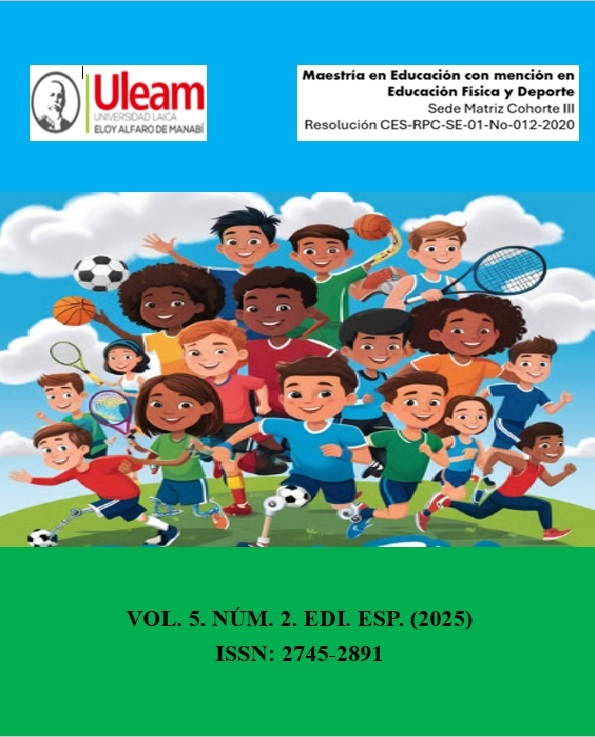Aerobic exercises to address burnout levels in teachers
Abstract
This study analyzes the impact of aerobic exercise on the reduction of burnout syndrome in teachers, a growing problem in the educational field that negatively affects emotional, physical and professional health. Burnout is manifested in three dimensions: emotional exhaustion, depersonalization and low personal fulfillment. The intervention, with a mixed approach and quasi-experimental design, was applied to 15 teachers previously identified with burnout indicators using the Maslach Inventory. It was structured in three stages: initial diagnosis, implementation of progressive aerobic routines, in this case Zumba (combination of dance routines and aerobic exercise) and post-intervention evaluation. Quantitative results revealed a statistically significant reduction in emotional exhaustion, while the depersonalization and self-fulfillment dimensions showed no significant differences. However, qualitative focus group analysis highlighted subjective improvements in emotional well-being, motivation and interpersonal relationships. The triangulation of data showed that, although the benefits were not statistically reflected in all dimensions, aerobic exercises contributed to the integral well-being of teachers. It is concluded that this physical practice represents a viable and effective tool to reduce emotional exhaustion, improve mental health and enhance educational quality through teacher self-care.
Downloads
References
Alejandra, M., & Guitart, A. (n.d.). EL Síndrome del burnout en las empresas. Alvarado-Peña, L., Amaya, R., Reyes, S., Muñoz, R., Ramos, E., & Sansores-Guerrero, E. (2023). Síndrome de burnout en profesores universitarios de latinoamérica: una revisión de literatura. Revista de Estudios Interdisciplinarios en Ciencias Sociales, 25(3), 802-818. https://www.redalyc.org/journal/993/99376074015/html
Bretland, R. y Thorsteinsson E. (2015). Reducing workplace burnout: the relative benefits of cardiovascular and resistance exercise. PeerJ, https://doi.org/10.7717/peerj.891
Camacho, C. (2020). Síndrome de burnout. Biodesarrollo y reversión de impactos en el sector de la salud del estado de Guanajuato, México. Region y Sociedad . https://www.scielo.org.mx/pdf/regsoc/v32/1870-3925-regsoc-32-e1308.pdf
Castañeda-Santillán, L. y Sánchez-Macías, A. (2022). Satisfacción laboral y burnout en personal docente. Retos Revista de Ciencias de la Administración y Economía, 12(24), pp. 230-246. https://doi.org/10.17163/ret.n24.2022.03
Colino, N. & Perez de Leon, P. (2015 ). El sindrome de burnout en un grupo de profesores de enseñanza.. Prensa Médica Latinoamericana
Fuentes-Núñez, J., Olivares-Gómez, C., Farías-Valenzuela, C., Poblete-Aro, C., Alvarez-Arangua, S. & Ferrero-Hernández, P. (2023). Beneficios del ejercicio y/o actividad física en los cinco tipos de cáncer con mayor incidencia y mortalidad a nivel mundial: Una revisión narrativa. SPORT TK-Revista EuroAmericana de Ciencias del Deporte, 12(10), 1-25. https://doi.org/10.6018/sportk.59842
Gabriel, R., Carrasco, A., Paulina, M., Rodriguez, P., Santillán Chávez, M., Fernando, C., Bayas, B., Karina, V. & Santilllán, A. (2018). Las causas del estrés y sus consecuencias en el desempeño laboral. www.eumed.net/rev/caribe/2018/07/estres-desempeno-laboral.html
Gerber, M., Brand, S., Elliot, C., Holsboer-Trachsler, E., Pühse, U. y Beck, J. (2013). Aerobic exercise training and burnout: a pilot study with male participants suffering from burnout. BMC Research Notes, 6(78), https://doi.org/10.1186/1756-0500-678
Gomez, J. (2023). Sistematización de experiencias de Bailoterapia y Aeróbicos en los ciudadanos del sector la. Retrieved from Tecnología Superior en Actividad Física, Deportiva y Recreación.: https://repositorio.tecnologicopichincha.edu.ec/bitstream/123456789/667/1/LAMI%c3%91A%20GOMEZ%20JOHANNA%20NICOLE.pdf
Jaqueline, A. (2014). El estrés un problema de salud del mundo actual . Con-ciencia , 115-124.
Lee, I. (2006). Beneficio de la actividad física para la prevención de las enfermedades crónicas en: Actas de Jornada Internacional de Actividad Física y Salud.
Llerena, K., Ávila, H., Moreano, A. & Flores, M. (2024). Beneficios del ejercicio de fuerza y aeróbico en adultos mayores con diabetes mellitus: Una revisión sistemática. Ciencia Y Educación, 726 - 737. https://doi.org/10.5281/zenodo.14563009
Mamani, N. (2021). Programa de aeróbicos en el estrés laboral para administrativos en La Una-Puno. Revista de Investigaciones, 10(2), 129-145. https://doi.org/10.26788/riepg.v10i2.2712
Márquez, J., Suárez, R., & Márquez, J. (2012). El ejercicio en el tratamiento de la diabetes mellitus tipo 2. Revista Argentina de endocrinología y metabolismo, 49(4). Obtenido de: https://www.scielo.org.ar/scielo.php?script=sci_arttext&pid=S1851-30342012000400006&lng=es&tlng=es
Méndez, Z., Escudero, L., Charcas, M., Gómez, R., Carrillo, M., Salinas, M. y López, I. (2024). Efectos de recibir atención nutricional sobre parámetros de composición corporal, antropométricos y bioquímicos en mujeres que practican Zumba. LATAM Revista Latinoamericana de Ciencias Sociales y Humanidades, 5(6), 1655–1669. https://doi.org/10.56712/latam.v5i6.3113
Olivares, V. (2017). Laudatio: Dra. Christina Maslach, Comprendiendo el Burnout. Ciencia & Trabajo, 19(58), 59–63. https://doi.org/10.4067/S0718-24492017000100059
Patton. (2002). Qualitative Research & Evaluation Methods. Sage Publications.
Philippe, P. (2020). Beneficios del ejercicio aeróbico para combatir la ansiedad de alumnosuniversitarios: revisión bibliográfica. Anuario De Investigación UM, 189-197.
Quipo, W. y Ushca, B. (2023). Ejercicios físicos aeróbicos para reducir el sobrepeso en los p dirección de familia ia del centro de educación Fiscal mixta Isaac J Barrera de Pifo-Paluguillo. [Tesis de pregrado, Universidad de las Fuerzas Armadas]. http://dx.doi.org/10.13140/RG.2.2.12620.49282
Rodriguez, J., Guevara, A. & Viramontes, E. (2017). Síndrome de burnout en docentes. Ie revista de investigación educativa de la radiech.Rojas, J. y Guillén, L. (2006). Trotar y Correr ayuda a vivir mejor. Luz, 5(1), 1-9. https://www.redalyc.org/pdf/5891/589165902005.pdf
Salazar, K. (2019). Ejercicios aeróbicos en mujeres con fibromialgia. Retrieved from http://dspace.unach.edu.ec/bitstream/51000/6334/1/EJERCICIOS%20AER%c3%93BICOS%20EN%20MUJERES%20CON%20FIBROMIALGIA%20KATERINE.pdf
Solán, E. (2019). Beneficios de la práctica de la zumba en la mujer adulta: programa de intervención desde terapia ocupacional. Retrieved from https://zaguan.unizar.es/record/88917#
Soulard, J., Nadeau, S., Vuillerme, N. & Duclos, N. (2024). Evaluación de la marcha: de la clínica al medio real. EMC - Kinesiterapia - Medicina Física, 45(2), 1-8. https://doi.org/10.1016/S1293-2965(24)48990-1
Torres, Y. (2011). Aplicación de un conjunto de ejercicios aeróbicos para el control y la disminución de la hipertensión arterial en los adultos mayores. EFDeportes.com, Revista Digital, (160), https://www.efdeportes.com/efd160/ejercicios-aerobicos-para-de-la-hipertension-arterial.htm
Zambrano, W. (2024). Síndrome del Burnout: Una Revisiónde la literatura. Imaginario Social, 1-20.
Zavala, J. (2008). Estrés y burnout docente: concepto, causas y efectos.
Copyright (c) 2025 Sandro Emiliano Zambrano Moreira ,Diana María Monge Cedeño

This work is licensed under a Creative Commons Attribution-NonCommercial-NoDerivatives 4.0 International License.






